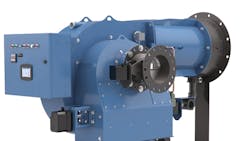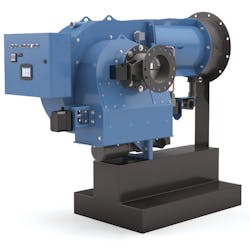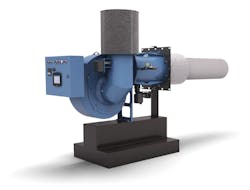New Trends in Burner Technology
The engineers who create burners for commercial boilers continually strive to develop high-efficiency, low-emissions products. However, emissions reduction often can come at the expense of efficiency and vice versa. The goal is to develop a low-emissions burner that does not sacrifice combustion efficiency.
There are two main emission-control technologies in the marketplace today: flue-gas recirculation (FGR) and surface-stabilized combustion using metal-fiber technology.
Flue-Gas Recirculation
In FGR, a portion of the exhaust (flue) gas circulates back into the combustion zone to lower the flame temperature and reduce nitrogen-oxide (NOx) formation. The exhaust gas of the boiler is metered and mixed with combustion air, cooling the flame without quenching it (Photo A). This mixed air is higher in temperature than ambient air and, based on the amount of mass flow and temperature, may impact a system’s fan-size and horsepower requirements. Cooling the flame excessively will cause a boiler to rumble and form soot and carbon monoxide (CO). As a result, a qualified technician should be present during installation.
FGR is recommended for facilities trying to achieve a NOx-emissions level below 30 ppm or 9 ppm. The amount of FGR needed depends on the NOx-emissions requirement. The lower the requirement, the more FGR must be added to the combustion-air supply. Typically, 15- to 20-percent FGR would be required for 30-ppm emissions, and 20- to 25-percent FGR would be required for 9-ppm emissions.
A system requires an additional valve to meter the amount of FGR intake. For precise control, an optional oxygen- (O2-) trim system is recommended to maintain the proper amount of FGR and excess air.
When FGR is used, boiler efficiency may decrease, typically in the range of 0.25 percent to 1 percent, depending on the amount of FGR added. There is a tradeoff between decreased flame temperature and reduction in radiation heat transfer that occurs in the furnace section of the boiler and the increase in convection heat transfer that occurs because of increased flow through the boiler. Some designs can make up this loss in the convection bank of the boiler better than others. In addition, it is important to note that FGR requires ongoing maintenance to manage condensation in the FGR lines. If the condensation reaches the internal area of the burner, it can damage the blower impeller and burner head.
Metal-Fiber Technology
Another process used to manage emissions is metal-fiber technology. This technology, which has emerged within the last five to 10 years, has become widely accepted among larger industrial-burner manufacturers. The process neither includes a traditional flame-stabilization diffuser, nor produces the more typical diffusion-based flame. Rather, the fuel and air are pre-mixed, and the flame is stabilized on a metal-fiber material. This surface-stabilized combustion stretches the flame, eliminates hot-flame zones, and reduces thermal NOx formation within the flame, enabling the burner to reach single-digit NOx levels without FGR (Photo B).
Metal-fiber burners typically require higher excess air to achieve low NOx. For a single-digit NOx-emissions requirement, this technology typically requires excess-air levels of 50 to 60 percent.
Metal-fiber technology will not eliminate the need for traditional burners that utilize FGR for NOx reduction. Future burner-design technology may, however, involve a combination of technologies, including premix, fuel or air staging, internal and external flue-gas recirculation, and other technologies that achieve ultralow NOx-emissions with minimal FGR.
Achieving Higher Efficiency
In recent years, ongoing research and development has increased burner efficiency. All burners have a specific turndown. Historically, the typical turndown on a burner was 4:1 or 5:1. With today’s technology and burner design, 10:1 can be achieved with good repeatability and relative ease of control.
If a burner has 10:1 turndown, it can operate at 10 percent of capacity (100 percent ÷ 10 = 10 percent). Compare that with a burner that has 4:1 turndown, which means it can operate at only 25 percent capacity. When demand falls below 25-percent, the boiler will meet the minimum process demand and then “cycle off” until more demand is needed. With 10:1 turndown, a boiler can turn down to 10 percent of capacity without cycling, preventing needless energy losses.
Selecting a burner that has lower excess air is another way to increase efficiency. Excess air also can be denoted as excess O2. Excess O2 is the amount of oxygen O2 in the incoming air not used during combustion and is related to the percentage of excess air. The percentage of excess air is the amount of air above the stoichiometric requirement for complete combustion. For example, 15-percent excess air equals 3-percent O2 while firing natural gas.
Many of today’s burners operate between 4 percent and 6 percent O2. The goal is to be between 3 percent and 4 percent O2. Lower excess air creates a higher-temperature flame and yields a more efficient burner. The proper amount of excess air must be added during the oxidation process in boiler combustion; otherwise, unburned fuel, soot, and CO will exhaust from the stack, polluting the environment while fouling the heat-transfer surfaces of the burner.
As a basic rule, for every 2-percent increase in O2, there is a 1-percent loss in efficiency. Today’s best burners can achieve the optimal 3-percent O2 throughout a majority of the firing range.
New control systems on the market today also help to increase efficiency. Controls maintain the burner-firing rate and the ability of a burner to modulate from low to high. They prevent hysteresis and maintain a set amount of excess air though the firing rate. However, it is unrealistic to put new controls on an old burner and expect a major reduction in emissions or turndown. New controls will increase repeatability, but it will not make a 3:1-turndown burner achieve a 10:1 turndown because the burner was not designed for it.
Advanced control and burner designs today allow for a burner to modulate from low to high fire while maintaining safe, but low excess-air levels throughout the turndown range. This holds true even for burners with 10:1 turndown. In a few years, the industry likely will see a burner that can achieve 10-ppm NOx without FGR or metal-fiber technology and can modulate from low to high fire while maintaining 3-percent 02.
Pawel Mosiewicz is the director of engineering, industrial combustion, for Industrial Combustion. Previously, he was research-and-development engineer for Maxon, a Honeywell company. He earned his master’s degree in mechanical engineering from the University of Illinois at Chicago.


